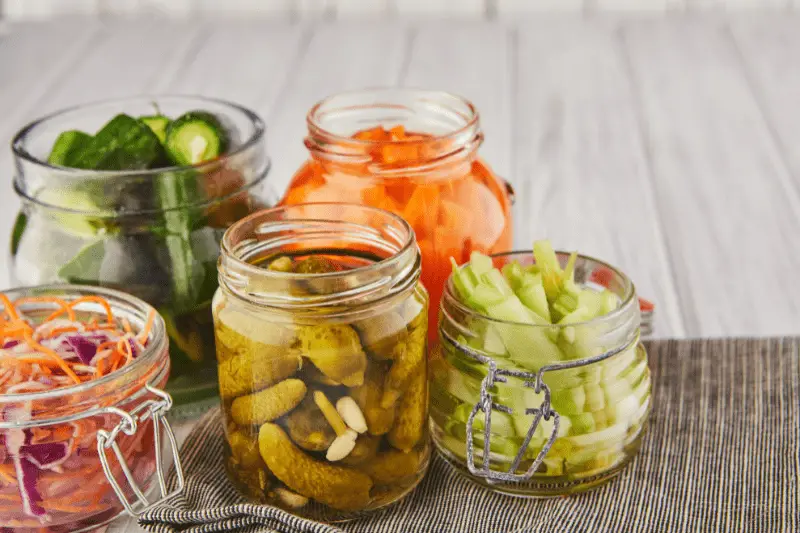Pickling is an ancient method of preserving food that has been around for thousands of years.
It’s a great way to extend the life of fruits and vegetables, and it can also add a delicious tangy flavor to your meals.
However, traditional pickling methods often involve adding large amounts of sugar and salt, which can be detrimental to your health.

Benefits of Pickling
Before we dive into the low-sugar pickling recipes, let’s first discuss the benefits of pickling.
Pickling is an excellent way to preserve fresh fruits and vegetables, which means you can enjoy them all year round.
It’s also a great way to reduce food waste, as you can pickle fruits and vegetables that are starting to go bad.
Additionally, pickling can add probiotics to your diet, which are beneficial for your gut health.
What is Low-Sugar Pickling?
Low-sugar pickling involves using less sugar and salt than traditional pickling methods.
This not only makes the pickles healthier, but it also allows the natural flavors of the fruits and vegetables to shine through.
In low-sugar pickling, vinegar is used as a preservative instead of sugar and salt.
Ingredients for Low-Sugar Pickling
To make low-sugar pickles, you will need the following ingredients:
- Fresh fruits or vegetables
- Vinegar
- Water
- Spices (optional)
- Sweetener (optional)
Low-Sugar Pickling Recipes
Here are some low-sugar pickling recipes that you can try at home:
1. Quick Pickled Cucumbers
Ingredients
- 1 large cucumber, thinly sliced
- 1/2 cup vinegar
- 1/2 cup water
- 1 tablespoon honey
- 1 teaspoon salt
- 1/2 teaspoon black pepper
- 1/2 teaspoon dried dill
Instructions
- Combine the vinegar, water, honey, salt, black pepper, and dried dill in a small saucepan.
- Heat the mixture over medium heat until the honey and salt are dissolved.
- Place the sliced cucumbers in a jar and pour the vinegar mixture over them.
- Let the cucumbers marinate in the refrigerator for at least 30 minutes before serving.
2. Pickled Carrots
Ingredients
- 2 cups sliced carrots
- 1/2 cup vinegar
- 1/2 cup water
- 1 tablespoon honey
- 1 teaspoon salt
- 1/2 teaspoon black pepper
- 1/2 teaspoon cumin
Instructions
- Combine the vinegar, water, honey, salt, black pepper, and cumin in a small saucepan.
- Heat the mixture over medium heat until the honey and salt are dissolved.
- Place the sliced carrots in a jar and pour the vinegar mixture over them.
- Let the carrots marinate in the refrigerator for at least 2 hours before serving.
3. Pickled Beets
Ingredients
- 2 cups sliced beets
- 1/2 cup vinegar
- 1/2 cup water
- 1 tablespoon honey
- 1 teaspoon salt
- 1/2 teaspoon black pepper
- 1/2 teaspoon ginger
Instructions
- Combine the vinegar, water, honey, salt, black pepper, and ginger in a small saucepan.
- Heat the mixture over medium heat until the honey and salt are dissolved.
- Place the sliced beets in a jar and pour the vinegar mixture over them. 4. Let the beets marinate in the refrigerator for at least 4 hours before serving.
Tips for Low-Sugar Pickling
Here are some tips to help you make the best low-sugar pickles:
- Use fresh fruits and vegetables for the best flavor.
- Experiment with different types of vinegar to find the one you like best.
- Don’t be afraid to add spices and herbs to your pickles for extra flavor.
- Use a sweetener such as honey or maple syrup to balance out the acidity of the vinegar.
- Let your pickles marinate in the refrigerator for at least a few hours to allow the flavors to develop.
Low-sugar pickling is a healthy and delicious way to enjoy fresh fruits and vegetables all year round.
By using less sugar and salt, you can create pickles that are not only good for you but also bursting with flavor.
Try out the recipes above or experiment with your own flavors to create your perfect low-sugar pickles.
FAQs
- Can I use any type of vinegar for low-sugar pickling? Yes, you can use any type of vinegar, such as white vinegar, apple cider vinegar, or rice vinegar.
- How long do low-sugar pickles last? Low-sugar pickles can last up to several weeks in the refrigerator.
- Can I use artificial sweeteners instead of honey or maple syrup? Yes, you can use artificial sweeteners, but be sure to use ones that are suitable for cooking.
- Can I reuse the pickling liquid? Yes, you can reuse the pickling liquid for up to 2-3 times, but be sure to refrigerate it between uses.
- Are there any fruits or vegetables that are not suitable for pickling? While most fruits and vegetables can be pickled, some fruits such as bananas or tomatoes do not hold up well in pickling liquid and are not recommended for pickling.
Vegetables that can be pickled using low-sugar recipes:
Cucumbers – Cucumbers are an excellent vegetable option for low-sugar pickling recipes. They are high in fiber, vitamins C and K, and also contain antioxidants that protect against disease.
Cauliflower – Cauliflower is a cruciferous vegetable that is low in calories and high in fiber. It’s high in vitamin C and K, as well as potassium and other essential nutrients.
Beets – Beets are loaded with essential vitamins, minerals, and antioxidants while being low in calories. They’re also a great source of fiber.
Cabbage – Cabbage is rich in vitamin C, K and B6, as well as minerals such as potassium. It’s an incredibly versatile vegetable that can be used for everything from sauerkraut to kimchi.
Benefits of Low-Sugar Pickling Recipes:
Low-sugar pickling recipes have several benefits.
Firstly they’re lower calorie which helps to support weight loss efforts or weight management goals more generally.
Secondly, by using natural sweeteners like stevia instead of sugar you still get the sweetness without the negative health consequences associated with sugar consumption such as spikes or crashes in blood sugar levels or an increased risk of type 2 diabetes.
Finally, pickled vegetables offer probiotics- bacteria essential for supporting gut health which may improve overall well-being.
